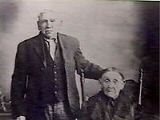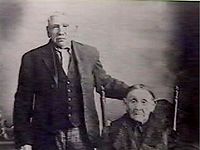
Lac-Simon, Outaouais, Quebec
Encyclopedia
Lac-Simon is a town and municipality in the Outaouais region of Quebec, Canada, part of the Papineau Regional County Municipality
.
It is known for its sandy beaches on Lake Simon and provides services to vacationers and campers.
Amable LeBlanc and his wife Marie-Louise Cimon, the niece of Basile Outik, chief of the Oka Indian tribe, went to settle on an island in the middle of a beautiful lake located 75 miles north-west of Oka
. Eight families left with him to this region where hunting and fishing were very good. Three of these families were related to the parents of his wife and from then on, the residents of Oka, and later those of Montebello
, called this lake "Lake Cimon", which became "Lake Simon". The largest island in the lake is now called White Duck Island (Île du Canard Blanc) in honour of Amable LeBlanc who was nicknamed "White Duck" in reference to his slightly lighter skin colour as compared to his native relatives.
 Starting in 1852, Franco-Catholic colonists began to settle at the lake, working as log drivers
Starting in 1852, Franco-Catholic colonists began to settle at the lake, working as log drivers
, loggers, or farmers. In 1857, a mission
was established. In 1864, Hartwell Township is formed (named after a place in central Buckinghamshire, England
), followed a few years later by the United Township Municipality of Hartwell-et-Suffolk. In 1880, the mission attained the status of parish under the name of Saint-Felix-de-Valois.
In 1881, Hartwell-et-Suffolk separated and formed the Township Municipality of Hartwell and the Township Municipality of Suffolk
. In 1893, Hartwell was merged with Preston Township, becoming the United Township Municipality of Hartwell-et-Preston.
In 1936, the united townships were separated again and formed Township Municipality of Hartwell and the Municipality of Duhamel
. In 1958, Hartwell becomes the Parish Municipality of Chénéville and finally becomes Municipality of Lac-Simon in 1965.
Lac-Simon's development as a resort area began in the 1950s, and accelerated when the Provincial Government acquired sites bordering the lake and opened a campground. Today, Centre touristique du Lac-Simon is a popular year-round vacation resort.
Total private dwellings (excluding seasonal cottages): 422 (total: 1206)
Languages:
Papineau Regional County Municipality, Quebec
Papineau is a county regional municipality of Quebec in Canada located in the Outaouais region. The regional seat is Papineauville.-Communities:*Cities and Towns**Thurso*Municipalities** Boileau** Bowman** Chénéville** Duhamel** Fassett...
.
It is known for its sandy beaches on Lake Simon and provides services to vacationers and campers.
History
In 1845, MétisMétis people (Canada)
The Métis are one of the Aboriginal peoples in Canada who trace their descent to mixed First Nations parentage. The term was historically a catch-all describing the offspring of any such union, but within generations the culture syncretised into what is today a distinct aboriginal group, with...
Amable LeBlanc and his wife Marie-Louise Cimon, the niece of Basile Outik, chief of the Oka Indian tribe, went to settle on an island in the middle of a beautiful lake located 75 miles north-west of Oka
Oka, Quebec
-References:...
. Eight families left with him to this region where hunting and fishing were very good. Three of these families were related to the parents of his wife and from then on, the residents of Oka, and later those of Montebello
Montebello, Quebec
Montebello is a municipality located in the Papineau Regional County Municipality of Western Quebec . As of the 2001 census, there were 1,039 permanent residents. The village has a total area of , and is located at the eastern edge of Canada's National Capital Region.The village is world famous for...
, called this lake "Lake Cimon", which became "Lake Simon". The largest island in the lake is now called White Duck Island (Île du Canard Blanc) in honour of Amable LeBlanc who was nicknamed "White Duck" in reference to his slightly lighter skin colour as compared to his native relatives.

Log driving
Log driving is a means of log transport which makes use of a river's current to move floating tree trunks downstream to sawmills and pulp mills.It was the main transportation method of the early logging industry in Europe and North America...
, loggers, or farmers. In 1857, a mission
Mission (station)
A religious mission or mission station is a location for missionary work.While primarily a Christian term, the concept of the religious "mission" is also used prominently by the Church of Scientology and their Scientology Missions International....
was established. In 1864, Hartwell Township is formed (named after a place in central Buckinghamshire, England
Hartwell
Hartwell is a village in central Buckinghamshire, England. It is to the south of Aylesbury, by the village of Stone.The village name is Anglo Saxon in origin, and means "spring frequented by deer". In the Domesday Book of 1086 it was recorded as Herdeuuelle and Herdewelle.The ruined Hartwell...
), followed a few years later by the United Township Municipality of Hartwell-et-Suffolk. In 1880, the mission attained the status of parish under the name of Saint-Felix-de-Valois.
In 1881, Hartwell-et-Suffolk separated and formed the Township Municipality of Hartwell and the Township Municipality of Suffolk
Saint-Émile-de-Suffolk, Quebec
Saint-Émile-de-Suffolk is a municipality in the Outaouais region of Quebec, Canada, part of the Papineau Regional County Municipality. Until 1994 it was known as United Township Municipality of Suffolk-et-Addington....
. In 1893, Hartwell was merged with Preston Township, becoming the United Township Municipality of Hartwell-et-Preston.
In 1936, the united townships were separated again and formed Township Municipality of Hartwell and the Municipality of Duhamel
Duhamel, Quebec
Duhamel is a town and municipality in the Outaouais region of Quebec, Canada. It is the largest municipality in surface area in the Papineau Regional County Municipality....
. In 1958, Hartwell becomes the Parish Municipality of Chénéville and finally becomes Municipality of Lac-Simon in 1965.
Lac-Simon's development as a resort area began in the 1950s, and accelerated when the Provincial Government acquired sites bordering the lake and opened a campground. Today, Centre touristique du Lac-Simon is a popular year-round vacation resort.
Demographics
Population:- Population in 2006: 869
- Population in 2001: 683
- 2001 to 2006 population change: 27.2 %
- Population in 1996: 667
- Population in 1991: 583
Total private dwellings (excluding seasonal cottages): 422 (total: 1206)
Languages:
- English as first language: 2 %
- French as first language: 97 %
- English and French as first language: 0 %
- Other as first language: 1 %

